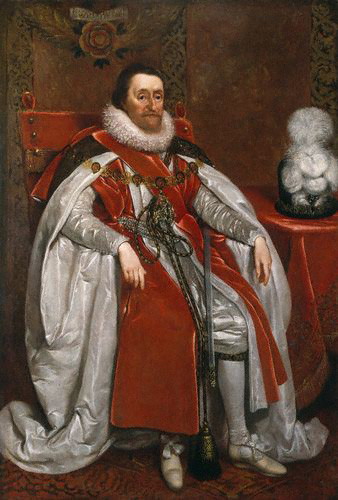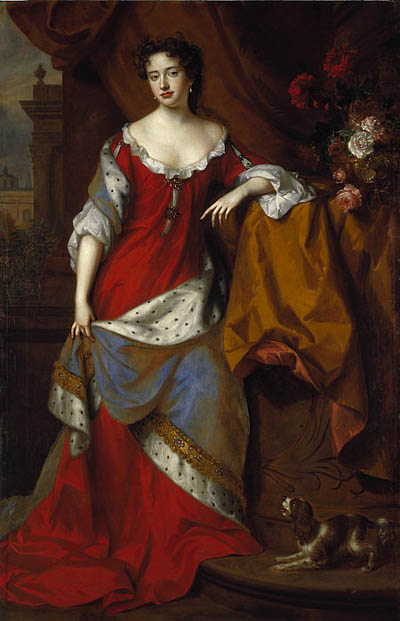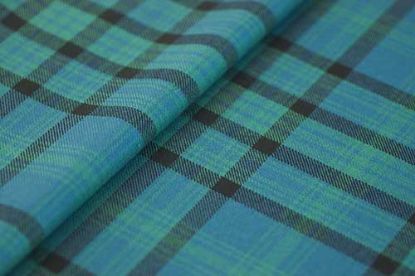Scottish Kings and Queens - James VI to Queen Anne.
House of Stuart (1567-1651) - Monarchs of Scotland, England, Wales and Ireland
WITH the marriage of Mary, Queen of Scots to Henry Stuart, Lord Darnley, son of the fourth Earl of Lennox and Lady Margaret Douglas, daughter of Princess Margaret Tudor (Queen Margaret of Scotland) by her second marriage to the sixth Earl of Angus, the succession of their son James to both the Scottish and English thrones became almost inevitable. Queen Mary and Lord Darnley were step-cousins, and great niece and great nephew respectively of Henry VIII of England. It should be noted that although the Queen and her husband were both of the Royal Stewart line, the French spelling of Stuart had lately been adopted by Lord Darnley's family.
 |
King James I of England and VI of Scotland, Daniel Mytens (c.1590-1648). Oil on canvas, 1621 |
KING James VI of Scotland was crowned at the Church of the Holy Rude in Stirling at so early an age that he would hardly have been aware of what was happening. At Stirling Castle he was placed under the tutelage of George Buchanan, a great scholar but tyrannical disciplinarian. It was Buchanan who instilled in the boy the virtues of a Classical education: Latin, Greek and, in particular, the Calvinist interpretation of the bible.
In 1570, the Regent Moray was assassinated and James' grandfather, Matthew, Earl of Lennox, replaced him. Lennox immediately set about strengthening his grandson's party, but this culminated in his being shot in the back at Stirling. The Earl of Mar then became Regent, followed by the Earl of Morton, and by 1572 supporters of Queen Mary had begun to disperse. By 1585, King James was in full control, and in many ways ruled his realm more successfully than any of his predecessors. Not without reason was he known as “The Wisest Fool in Christendom”
With the death of his cousin Elizabeth I in 1603, he succeeded to the English throne. Scotland had achieved over England something that England had never achieved over Scotland. A King of Scots was now King of England. Taking leave of his Scottish kingdom, James promised to return, but did so only once, in 1617, and this was to impose the “Five Articles” which proclaimed that Holy Communion should be received while kneeling. The response to this decree was violent and fuelled the religious protests that would tarnish Scotland for generations to come. He died in March 1625.
1625-49 Charles I
THE Scottish kingdom which Charles I inherited in 1625 remained loyal to the Crown and had prospered in the absence of its resident monarch. However, unlike his father, Charles was rigidly inflexible and had no real understanding of the people he ruled.
Born in the Palace of Dunfermline, his elder brother Henry had been groomed to succeed their father, but his early death changed everything. Moreover, Charles' marriage to the Catholic Princess Henrietta Maria of France alienated both his Presbyterian and Anglican subjects.
In 1633, he returned to Scotland to be crowned in the Chapel of Holyrood House, ordering that English rites be used. To the staunch upholders of the Church of Scotland this was a direct affront. Similarly, his preoccupation with the Divine Right of Kings was to do him no favours.
In 1638, the Scots rose up in protest against episcopal government and drew up the National League and Covenant, based on James' 1581 Negative Confession of Faith drawn up against Catholics. In Edinburgh's Greyfriars Churchyard nobility, clergy and burgesses alike appended their signature defiant of their king. Nevertheless, although the Covenant attacked Catholicism and rejected Anglican ideology in favour of established Presbyterian practice, it also underlined a widespread loyalty to the Crown. When Civil War broke out in England, the King therefore appealed to Scotland for help. Visiting Edinburgh, he approved the General Assembly's 1638 motion to abolish episcopacy and the Revised Prayer Book, and agreed that the Scottish Parliament should be allowed to challenge his ministers. However, he had conceded matters too late.
After the Royalists had won their early battles in England, the Parliamentarians led by Oliver Cromwell turned to Scotland for support. There then ensued a struggle between the Marquis of Montrose, loyal to the Monarchy, and the Marquis of Argyll, who favoured Parliament. The King was defeated at the Battle of Naseby, and having escaped from the Siege of Oxford, ill-advisedly surrendered himself to the Scottish Presbyterian Army at Newark.
Charles was handed over to the English Parliament and sent for trial. On 20th January 1649 he was executed at Whitehall. News of his death was received by a Scotland in a state of shock.
The Commonwealth Protectorate (1652-1660)
OLIVER Cromwell was appointed Lord Protector of England, Scotland and Ireland by the British Parliament, a monarch in all but name. When he died in 1658, he was briefly succeeded by his son Richard Cromwell. In 1660, elections were held and Charles I's eldest son was invited to ascend the British throne as Charles II
OLIVER Cromwell was appointed Lord Protector of England, Scotland and Ireland by the British Parliament, a monarch in all but name. When he died in 1658, he was briefly succeeded by his son Richard Cromwell. In 1660, elections were held and Charles I's eldest son was invited to ascend the British throne as Charles II
Restoration of the House of Stuart (1660-1707)
1651-85 Charles II
HAVING agreed to accept the Scottish “Deed of Covenant”, Charles II was crowned King of Scots at Scone in 1651. The Scots then invaded England, but were routed at the Battle of Worcester. Charles fled to France, then to the Netherlands, until invited to return to England as Monarch in 1660. Through a policy of religious tolerance, Charles II's reign brought a welcome relief from the stringent Puritanism of the Protectorate. He married Catherine of Braganza, daughter of the King of Portugal, but there were no legitimate children.
1685- 89 James VII (and II of England)
KING Charles' younger brother, James, Duke of York served as Commissioner for Scotland in 1679. He had married Anne Hyde, daughter of the Earl of Clarendon, in 1659, and they had two daughters. However, two years after Queen Anne's death in 1671, he married Mary, daughter of the Duke of Medina, and Prince James Francis Edward was born in 1688. As a devout Catholic, there had always been reservations about James becoming King. If he had been prepared to keep his religion to himself, his fate might have been very different. However, he now seemed intent upon establishing a Catholic ascendancy through his son. In Scotland, the persecution of the Covenanters had been renewed with vigour. In 1685, a failed bid for the throne by his illegitimate nephew, the Duke of Monmouth, married to the Duchess of Buccleugh in her own right, led to widespread disaffection, especially when Monmouth was executed. Matters finally came to a head, and seven leading politicians approached James' son-in-law, the Protestant William, Prince of Orange, for help. William landed in England with a large army in 1688 and marched on London. King James and Queen Mary, with Prince James Francis, fled to France, where they remained under the protection of King Louis XIV.
1689-94 Mary and
1689-1701 William II (of Orange)
IN 1677, Princess Mary, daughter of James VII and II and Queen Anne, had married her cousin, the posthumous son of William II of Orange by Princess Mary, eldest daughter of Charles I. As James and his policies became increasingly unpopular, the Protestant William was persuaded to invade England to oust his father-in-law. He did so in 1688, landing at Torbay with an impressive English and Dutch army and James fled to France. In February 1689, William and Mary were proclaimed King and Queen. The Scottish Convention ratified this in April. James' followers, however, continued to fight his cause in Scotland and Ireland, but the battles of Killiecrankie in Scotland in 1689 and Limerick in Ireland in 1691, ended the resistance. Mary died in 1694, and they had no children.
 |
Queen Anne, at the time of her marriage in 1683, Willem Wissing (1656 - 1687), and Jan van der Vaardt (1647-1721). Oil on canvas, 1685-6 |
THE second daughter of King James VIII, Queen Anne and her sister were brought up as members of the Church of England. In 1683, she married Prince George of Denmark, On her brother-in-law's invasion in 1688, she supported his party but soon found herself embroiled in intrigues to reinstate her father and half-brother. Tragically, she gave birth to seventeen children, but none of them survived infancy.
























